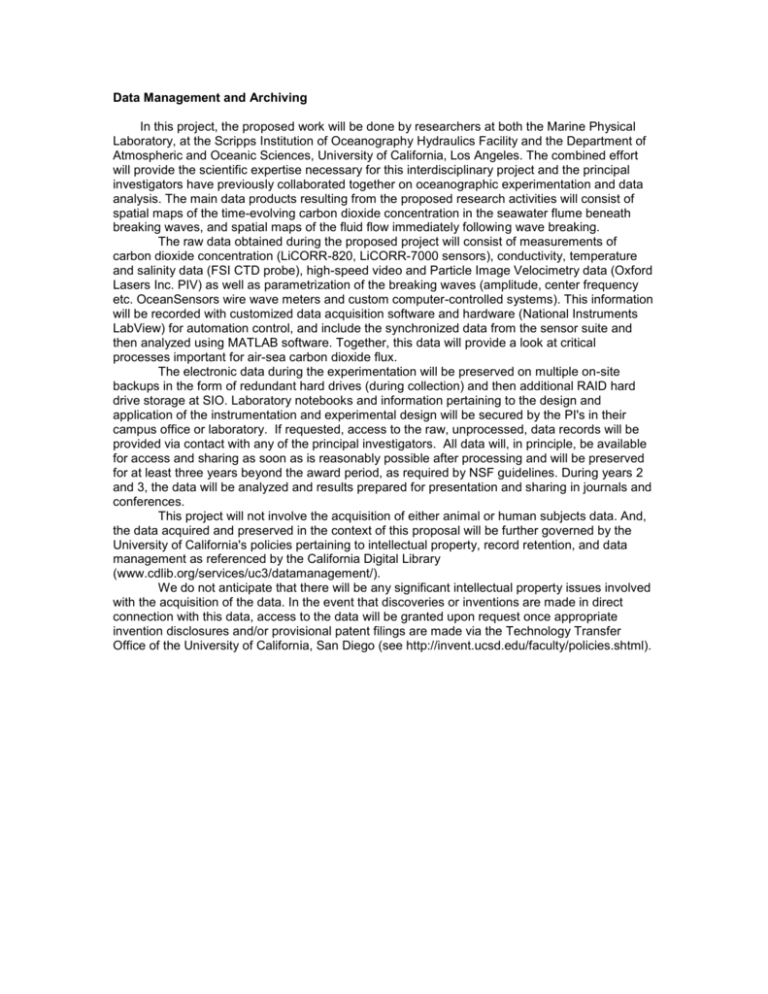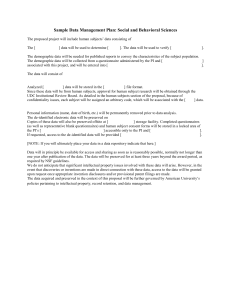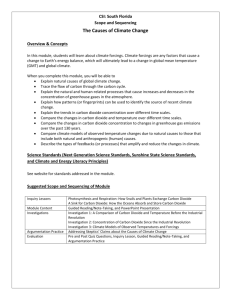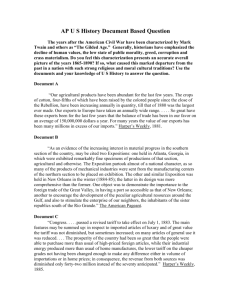DMP Example SIO-PO - The Library
advertisement

Data Management and Archiving In this project, the proposed work will be done by researchers at both the Marine Physical Laboratory, at the Scripps Institution of Oceanography Hydraulics Facility and the Department of Atmospheric and Oceanic Sciences, University of California, Los Angeles. The combined effort will provide the scientific expertise necessary for this interdisciplinary project and the principal investigators have previously collaborated together on oceanographic experimentation and data analysis. The main data products resulting from the proposed research activities will consist of spatial maps of the time-evolving carbon dioxide concentration in the seawater flume beneath breaking waves, and spatial maps of the fluid flow immediately following wave breaking. The raw data obtained during the proposed project will consist of measurements of carbon dioxide concentration (LiCORR-820, LiCORR-7000 sensors), conductivity, temperature and salinity data (FSI CTD probe), high-speed video and Particle Image Velocimetry data (Oxford Lasers Inc. PIV) as well as parametrization of the breaking waves (amplitude, center frequency etc. OceanSensors wire wave meters and custom computer-controlled systems). This information will be recorded with customized data acquisition software and hardware (National Instruments LabView) for automation control, and include the synchronized data from the sensor suite and then analyzed using MATLAB software. Together, this data will provide a look at critical processes important for air-sea carbon dioxide flux. The electronic data during the experimentation will be preserved on multiple on-site backups in the form of redundant hard drives (during collection) and then additional RAID hard drive storage at SIO. Laboratory notebooks and information pertaining to the design and application of the instrumentation and experimental design will be secured by the PI's in their campus office or laboratory. If requested, access to the raw, unprocessed, data records will be provided via contact with any of the principal investigators. All data will, in principle, be available for access and sharing as soon as is reasonably possible after processing and will be preserved for at least three years beyond the award period, as required by NSF guidelines. During years 2 and 3, the data will be analyzed and results prepared for presentation and sharing in journals and conferences. This project will not involve the acquisition of either animal or human subjects data. And, the data acquired and preserved in the context of this proposal will be further governed by the University of California's policies pertaining to intellectual property, record retention, and data management as referenced by the California Digital Library (www.cdlib.org/services/uc3/datamanagement/). We do not anticipate that there will be any significant intellectual property issues involved with the acquisition of the data. In the event that discoveries or inventions are made in direct connection with this data, access to the data will be granted upon request once appropriate invention disclosures and/or provisional patent filings are made via the Technology Transfer Office of the University of California, San Diego (see http://invent.ucsd.edu/faculty/policies.shtml).











